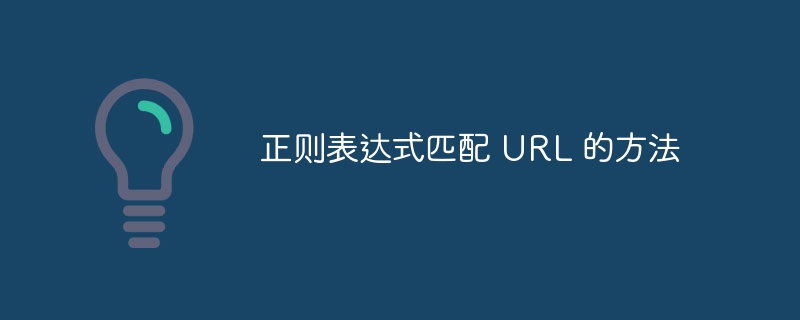Methods for regular expression matching URLs
Methods for regular expressions to match URLs include: Match typical URLs: (?:https?://|www.)\S .\S Extract URL Component: Protocol: ^(?:https?://|www.) Domain name: \w (?:.\w ) File path: \S*.(?:html|php|js|css) Match a specific type of URL: Image URL: (?:https?://|www.)\S .(?:jpg|jpeg|png|gif)PDF URL: (?:https?://|www.)\S .pdf

Methods for regular expressions to match URLs
Match URLs using regular expressions
Regular expressions are a powerful pattern matching language that can be used in a variety of text processing tasks, including matching URLs. The following regular expressions can match typical URLs:
<code>(?:https?://|www\.)\S \.\S</code>
Interpretation of parts of regular expression:
- (?:https?://|www.) : This section matches the protocol part (http or https) or "www" prefix in the URL.
- \S : Match one or more non-whitespace characters to capture the domain name.
- .\S : Match a period ("."), followed by one or more non-whitespace characters, capturing the top-level domain or file extension.
Example:
The following URL conforms to the given regular expression:
- https://www.google.com/search
- http://example.com/index.html
- www.wikipedia.org
Extract URL components using regular expressions
In addition to matching URLs, regular expressions can also be used to extract various components of the URL, such as protocols, domain names, and file paths. Here are the regular expressions used to extract these components:
protocol:
<code>^(?:https?://|www\.)</code>
domain name:
<code>\w (?:\.\w )</code>
File path:
<code>\S*\.(?:html|php|js|css)</code>
Use regular expressions to match URLs of specific types
Regular expressions can also be used to match URLs of specific types, for example:
Image URL:
<code>(?:https?://|www\.)\S \.(?:jpg|jpeg|png|gif)</code>
PDF URL:
<code>(?:https?://|www\.)\S \.pdf</code>
The above is the detailed content of Methods for regular expression matching URLs. For more information, please follow other related articles on the PHP Chinese website!

Hot AI Tools

Undresser.AI Undress
AI-powered app for creating realistic nude photos

AI Clothes Remover
Online AI tool for removing clothes from photos.

Undress AI Tool
Undress images for free

Clothoff.io
AI clothes remover

Video Face Swap
Swap faces in any video effortlessly with our completely free AI face swap tool!

Hot Article

Hot Tools

Notepad++7.3.1
Easy-to-use and free code editor

SublimeText3 Chinese version
Chinese version, very easy to use

Zend Studio 13.0.1
Powerful PHP integrated development environment

Dreamweaver CS6
Visual web development tools

SublimeText3 Mac version
God-level code editing software (SublimeText3)

Hot Topics
 1655
1655
 14
14
 1413
1413
 52
52
 1306
1306
 25
25
 1252
1252
 29
29
 1226
1226
 24
24
 How to use bootstrap in vue
Apr 07, 2025 pm 11:33 PM
How to use bootstrap in vue
Apr 07, 2025 pm 11:33 PM
Using Bootstrap in Vue.js is divided into five steps: Install Bootstrap. Import Bootstrap in main.js. Use the Bootstrap component directly in the template. Optional: Custom style. Optional: Use plug-ins.
 Understanding HTML, CSS, and JavaScript: A Beginner's Guide
Apr 12, 2025 am 12:02 AM
Understanding HTML, CSS, and JavaScript: A Beginner's Guide
Apr 12, 2025 am 12:02 AM
WebdevelopmentreliesonHTML,CSS,andJavaScript:1)HTMLstructurescontent,2)CSSstylesit,and3)JavaScriptaddsinteractivity,formingthebasisofmodernwebexperiences.
 The Roles of HTML, CSS, and JavaScript: Core Responsibilities
Apr 08, 2025 pm 07:05 PM
The Roles of HTML, CSS, and JavaScript: Core Responsibilities
Apr 08, 2025 pm 07:05 PM
HTML defines the web structure, CSS is responsible for style and layout, and JavaScript gives dynamic interaction. The three perform their duties in web development and jointly build a colorful website.
 How to write split lines on bootstrap
Apr 07, 2025 pm 03:12 PM
How to write split lines on bootstrap
Apr 07, 2025 pm 03:12 PM
There are two ways to create a Bootstrap split line: using the tag, which creates a horizontal split line. Use the CSS border property to create custom style split lines.
 How to insert pictures on bootstrap
Apr 07, 2025 pm 03:30 PM
How to insert pictures on bootstrap
Apr 07, 2025 pm 03:30 PM
There are several ways to insert images in Bootstrap: insert images directly, using the HTML img tag. With the Bootstrap image component, you can provide responsive images and more styles. Set the image size, use the img-fluid class to make the image adaptable. Set the border, using the img-bordered class. Set the rounded corners and use the img-rounded class. Set the shadow, use the shadow class. Resize and position the image, using CSS style. Using the background image, use the background-image CSS property.
 How to set up the framework for bootstrap
Apr 07, 2025 pm 03:27 PM
How to set up the framework for bootstrap
Apr 07, 2025 pm 03:27 PM
To set up the Bootstrap framework, you need to follow these steps: 1. Reference the Bootstrap file via CDN; 2. Download and host the file on your own server; 3. Include the Bootstrap file in HTML; 4. Compile Sass/Less as needed; 5. Import a custom file (optional). Once setup is complete, you can use Bootstrap's grid systems, components, and styles to create responsive websites and applications.
 How to use bootstrap button
Apr 07, 2025 pm 03:09 PM
How to use bootstrap button
Apr 07, 2025 pm 03:09 PM
How to use the Bootstrap button? Introduce Bootstrap CSS to create button elements and add Bootstrap button class to add button text
 How to resize bootstrap
Apr 07, 2025 pm 03:18 PM
How to resize bootstrap
Apr 07, 2025 pm 03:18 PM
To adjust the size of elements in Bootstrap, you can use the dimension class, which includes: adjusting width: .col-, .w-, .mw-adjust height: .h-, .min-h-, .max-h-




